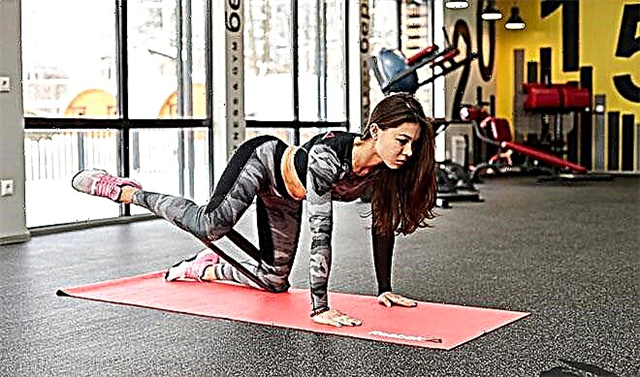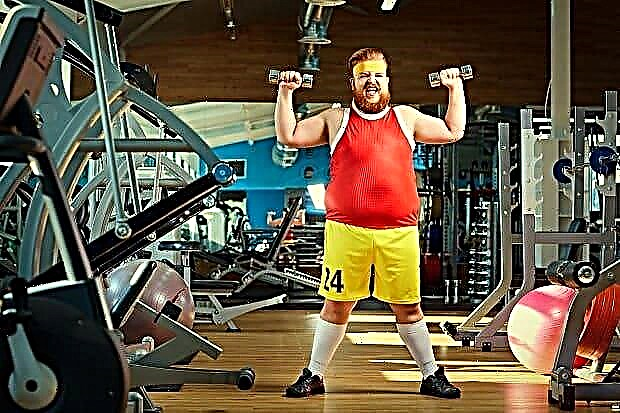The bench press is a basic strength exercise that involves lowering and lifting the bar while lying on a horizontal bench. Bench press is probably the most widespread exercise in the world, you will hardly find at least one gym where almost every athlete does not perform this exercise. This exercise is one of those in which you can work with large weights due to the anatomical comfort of the flat bench press, and this is a great opportunity to unleash your genetic strength potential.
When I talk about big weights, I mean really impressive figures that can shock any beginner. The current world record in the bench press without equipment belongs to Russian Kirill Sarychev and is equal to a mind-boggling 335 kg. Kirill set this record in Moscow in November 2015, and who knows what result the athlete will attempt at the next competition. The Russian hero is only 27 years old, and I am sure that new records will not be long in coming, if only there are no injuries.
In our article today we will understand:
- Why do bench press;
- How to do a bench press with a barbell;
- Typical mistakes;
- What are the alternatives to the classic bench press;
- How to increase the bench press;
- Bench Press Standards;
- Crossfit complexes containing bench press.
Why do the barbell bench press?
The bench press is a versatile exercise suitable for developing an athlete's overall strength and gaining muscle mass in the pectoral muscles and throughout the shoulder girdle. In this case, the style of performing the bench press "for strength" and "for weight" in most cases is different.
When performing a press for strength, we work in a small range of repetitions (usually no more than six), we do each repetition in full amplitude, fixing the bar at the bottom and top points. In order to reduce the amplitude, and also to include more muscles in the work, the athlete does a kind of exercise "bridge" lying on the bench. In this case, the grip is used as wide as possible (the maximum allowed according to the rules of powerlifting is 81 cm).
When lifting weights, an excellent bench press is short range work. We do not fully extend the elbows, we work without pauses, so the pectoral muscles and triceps are under constant tension. At the same time, the athlete does not bend on the bench in order to reduce the amplitude, but lies flat on the bench; some experienced athletes even prefer to put their feet on the edge of the bench or keep them in the air just above the level of the body. The meaning is clear - this way we have fewer points of contact and do not involve antagonist muscles in the work.
The main working muscle groups when performing the bench press: chest, triceps and front deltas.

© Makatserchyk - stock.adobe.com
If we press in a power style, trying to connect as many muscles as possible, we help ourselves a little with the quadriceps, spinal extensors and latissimus dorsi, since they are in constant static tension and do not turn off from work for a second.
Technique for performing a bench press
Below is a classic bench press technique that will work for most athletes. Depending on the level of your physical fitness, you can complicate and modify it, for example, work without support in your legs or use additional equipment that complicates the control of movement: rubber loops or chains. Let's figure out how to do the bench press with a barbell correctly.
Starting position
We take the starting position: we lie down on the bench, we try to bring the shoulder blades together and bend slightly in the lower back, while the buttocks, upper back and head should be tightly pressed against the bench. We rest our feet tightly on the floor, statically strain the quadriceps. The bar should be at approximately eye level.
We decide on the width of the grip: the wider we place the hands, the shorter the amplitude, and the more the pectoral muscles are involved in the work. The wider we put the hands, the smaller the amplitude, and the more the triceps and front delts work. Here we work through trial and error.
I recommend starting with a grip slightly wider than the shoulders, so we will evenly distribute the load between all working muscle groups.
Do not start pressing with too wide a grip, as you may feel discomfort in the shoulder joints and unpleasant tightness in the chest. To work comfortably with large weights with a wide grip, pay attention to careful stretching of the pectoral muscles, this will really allow you to increase the result.
Once we have decided on the setting of the hands, it is necessary to remove the barbell from the racks. To do this, statically tense your triceps and try to fully extend your elbows, squeezing the bar firmly.

© Artem - stock.adobe.com
Barbell bench press
Remove the barbell from the racks and bring it slightly forward, it should be at the level of the bottom of the chest.
- We smoothly and under control lower the barbell down, accompanying this movement with a deep breath. Without making any sudden movements, put the barbell on the bottom of your chest. If you are working on strength, I recommend pause on the chest for 1-2 seconds, so the pressing movement will turn out to be more explosive. If you are working on a mass, it is not necessary to do this, start pressing immediately after touching the bottom of the chest with the barbell.
- We squeeze the bar up with the effort of the pectoral muscles and triceps. We make a powerful exhalation. In this case, the elbows should not change their position, the "institution" of the elbows inward is fraught with injury. To mentally concentrate better on the barbell press, try the following trick: as soon as you start lifting the barbell, try to push your whole body into the bench as much as possible, as if "moving away" from the barbell, thereby setting powerful acceleration for lifting the projectile. This way you can better feel the biomechanics of movement and can lift more weight. Once you have completed the full repetition and the elbows are fully extended, repeat again.
- Place the barbell back on the racks, moving it slightly with a shoulder movement towards the head.

© Artem - stock.adobe.com
I repeat, this technique is just a sample of the bench press, but depending on your goals, it can be modified. If you are doing powerlifting, you need to do a strong arch in the lower back to shorten the amplitude, and also help yourself a little with your lats and legs, squeezing the bar up. If you are more interested in the bench press for the maximum number of repetitions, you should lower the barbell to the chest as quickly as possible so that it "bounces" off the chest and passes part of the amplitude due to the inertia force. If your goal is to thoroughly work the pectoral muscles, lower the bar down more smoothly, concentrating on stretching and contracting the lower pectoralis.
Common beginner mistakes
Many gym goers manage to get serious injuries while doing bench presses. In order not to repeat their fate, I recommend remembering the following information and never doing so.
- Never neglect warm up - it will warm up your joints and ligaments and help you better control movement.
- Use the right shoes... You cannot do a normal bench press in slippers or flip-flops, you cannot properly rest on the floor.
- The stage of removing the bar from the racks is the most inconvenient and traumatic. Feel free to ask someone at the gym to help you lift the barbell.
- Find a normal belayer, who himself achieved good results in the bench press. The partner's help here should be smooth and accurate, and not a sharp rise.
- Be careful with your back room, particularly negative reps. This is, of course, an excellent tool for increasing strength indicators, but you should not resort to it if your working weight in the bench press is less than at least 100 kg - your articular-ligamentous apparatus may simply not be ready for this.
- Many beginners lift their glutes off the bench with the bench press. This is not worth doing - there is a strong compression on the intervertebral discs in the lumbar spine. Give yourself the mental attitude that you should always lean on the bench with three points: your buttocks, upper back and the back of your head.

What other mistakes are common among beginners? Watch the video:
What are the alternatives to the classic bench press?
The bench press is a multi-joint exercise for those who like really hard plowing in the gym. Few exercise can match it in effectiveness. But for those who, for one reason or another, cannot perform this exercise with the correct technique, we recommend trying one of the following exercises instead of the classic bench press:
Dumbbell bench press lying on a horizontal bench
Dumbbells allow us to work with greater amplitude than a barbell, thereby stretching the pectoral muscles better and working more in isolation. The technique of these two exercises is similar, but when working with dumbbells, you should pay more attention to the negative phase of the movement - the movement should be very smooth and controlled.

Dips on the uneven bars
By doing dips on the uneven bars, we can perfectly work out the lower chest and triceps. To make the dumbbells heavier, you can use additional weights, start with one 5kg pancake or small dumbbell and gradually increase the weight of the weights. However, do not overdo it with weight, as there is too much stress on the elbow joints. Another option for weights is the chains on the neck, so your torso leans forward more, and the pectoral muscles get more stress.

Bench press in Smith
With Smith, we spend less effort maintaining a consistent trajectory. The press in Smith is well suited for beginners or athletes who are poor at monotonous work with the bar in the same plane.

© lunamarina - stock.adobe.com
Bench press in block or lever machines
Almost every modern gym or fitness club is equipped with a variety of machines that mimic the chest press movements. Let's be honest, most of them are absolutely useless, but in some of them the load vector is set very competently, which allows you to work out the lower or inner parts of the pectoral muscles well. Do not chase the maximum weights in these exercises, work with comfortable weights, with which you feel well the contraction of the necessary muscles, in the range of 10-15 repetitions, we are not interested in power records here.

© Makatserchyk - stock.adobe.com
How to increase strength in the bench press?
As with any basic movement, the key to increasing weights lies in properly distributing the load and performing ancillary exercises for the muscles involved in the movement. How to increase the bench press?
With load distribution, things are quite simple. The bench press is a resource-intensive exercise, so it should come as no surprise that you cannot progress from workout to workout unless you have phenomenal genetics. Press workouts should be alternated according to their severity and intensity. For example, in one workout we work with large weights in a small repetition range, in the next we do a multi-rep or bench press with a pause on the chest with an average weight, and also work on the pectoral muscles at different angles, using dumbbell press on an incline bench, push-ups on uneven bars, dumbbell spreads and other exercises. An integrated approach to training and an isolated study of small muscle groups is an obligatory part of the training process for athletes who are fond of the bench press.
Assistance exercises
There are a huge number of auxiliary exercises for increasing the one-time maximum in the bench press, so do not be afraid to diversify your training process - this will certainly lead to positive results and overcome the "stagnation". Let's look at the most common ones:
- Bench press with a pause. By completely stopping the movement and extinguishing the inertia force, the bench press turns out to be more powerful and faster, the explosive strength of the pectoral muscles and triceps develops well. It is performed with a weight of 20-30% less than a one-time maximum.
- Bench press in limited amplitude. Using a special block or stoppers, we work with a lot of weight, without completely lowering the barbell to the chest. This exercise perfectly strengthens ligaments and tendons and psychologically helps us get used to heavy weights.
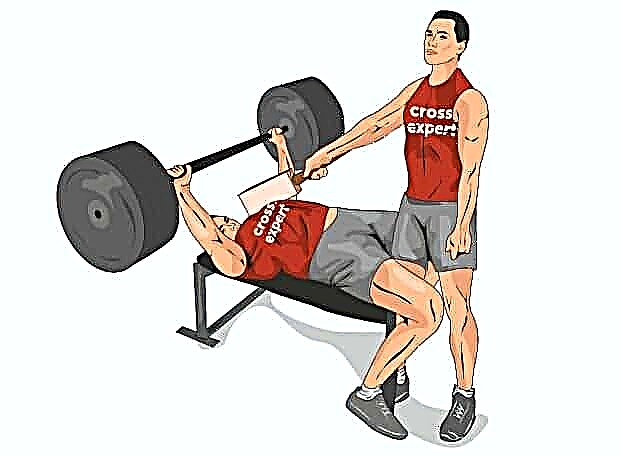
- Press from the floor. This exercise can be performed with a barbell or with dumbbells. The point is that at the lowest point we lean on the floor with triceps and work along a shortened trajectory. Develops a good sense of control over the projectile.
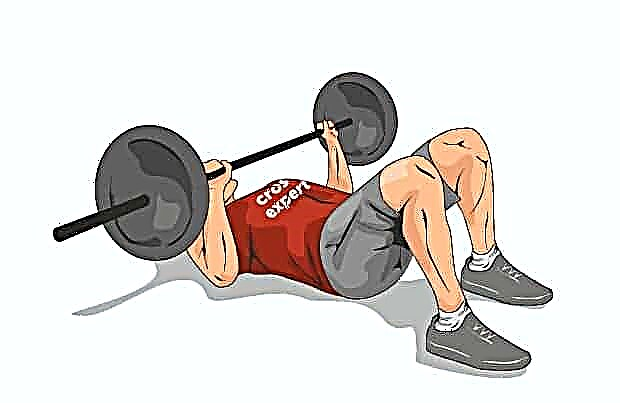
- Negative repetition. It is performed with a weight of 15-30% more than the maximum. We lower the barbell to the chest as slowly as possible, and squeeze it up with the help of a partner. It stretches the pectoral muscles well and trains the strength of the ligaments and tendons.
- Bench press with chains. If your gym is equipped with heavy metal chains, you can safely use them in your workouts. We hang the chains along with the pancakes and do the bench press. The chain should be long enough so that most of it is on the floor at the bottom. Pressing the bar becomes much more difficult as the chains make the bar heavier and heavier as you lift.
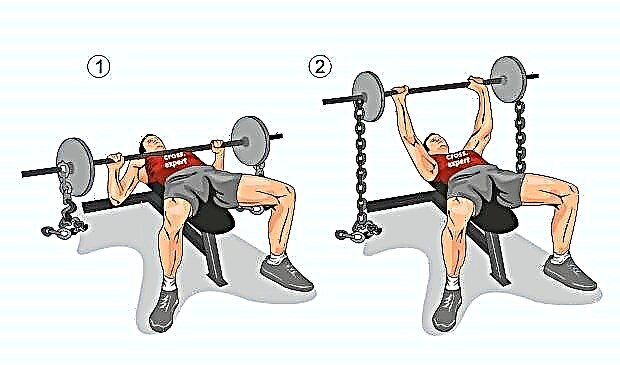
- Army press (standing barbell press). Separately loads the front bundle of deltas, which takes about a third of the load during the bench press. Strong shoulders are the key to a strong bench press.
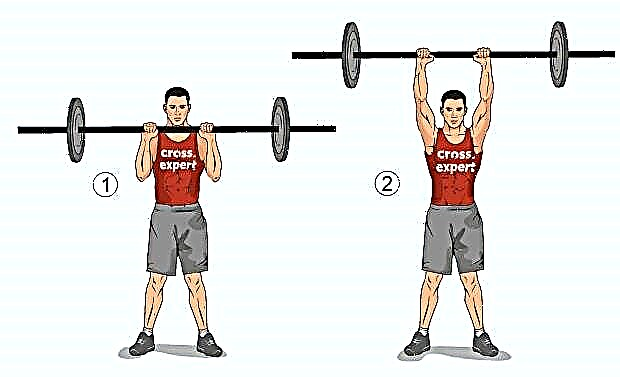
- Bench press with a narrow grip. Shifts the emphasis of the load on the triceps and the inner part of the chest. The work is complicated by the fact that the range of motion becomes larger due to the narrow position of the hands. In this case, the elbows should go along the body.
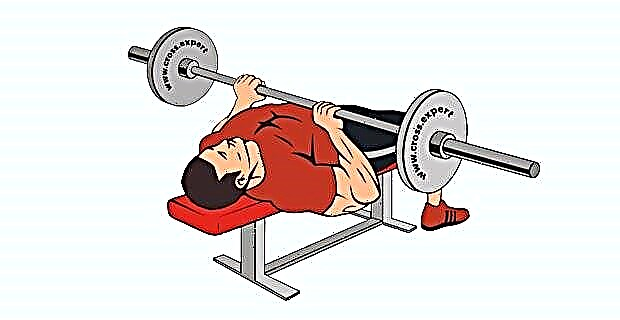
- Laying dumbbells lying on a horizontal bench. It's no secret that stretching plays a huge role in the progression of strength performance. It is the wiring that best cope with this task, making the fascia of the pectoral muscles more plastic, which greatly simplifies lowering a heavy barbell to the chest. Other similar exercises, such as crossover information or "butterfly", in my opinion, are less effective, but they also take place at certain stages of the training process.
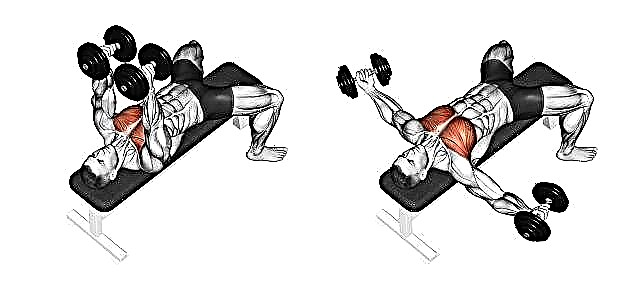
© Makatserchyk - stock.adobe.com
Bench Press Guidelines 2019
In Russia, bench press competitions are held under the auspices of many federations. However, the official federation (Federation of Powerlifting of Russia - FPR) recently included the un-equipped division in the bench press into its competence, and its standards have not yet been fully spelled out, the standards for MS, MSMK and Elite have not yet been determined.
Equipment powerlifting and bench press are controversial disciplines, and we will probably skip their discussion today. For this reason, the most popular for benchers and most powerlifters in our country, performing without equipment, is the alternative federation WPC / AWPC (division with doping control / without doping control), which offers to fulfill the following standards (I must say, very democratic) for assignment to a member sports federation:
MEN'S SIZE CHART (AWPC)
(BAR PRESS WITHOUT EQUIPMENT)
| Weight category | Elite | MSMK | MC | CCM | I | II | III | I jun. | II jun. |
| 52 | 127.5 | 110 | 95 | 82.5 | 75 | 67.5 | 57.5 | 47.5 | 37.5 |
| 56 | 137.5 | 120 | 102.5 | 90 | 80 | 72.5 | 62.5 | 52.5 | 42.5 |
| 60 | 147.5 | 127.5 | 112.5 | 97.5 | 87.5 | 77.5 | 67.5 | 55 | 45 |
| 67.5 | 165 | 142.5 | 125 | 107.5 | 97.5 | 87.5 | 75 | 62.5 | 50 |
| 75 | 180 | 155 | 135 | 117.5 | 105 | 95 | 82.5 | 67.5 | 55 |
| 82.5 | 192.5 | 167.5 | 145 | 127.5 | 112.5 | 102.5 | 87.5 | 72.5 | 57.5 |
| 90 | 202.5 | 175 | 152.5 | 132.5 | 120 | 107.5 | 92.5 | 77.5 | 60 |
| 100 | 215 | 185 | 162.5 | 140 | 125 | 112.5 | 97.5 | 80 | 65 |
| 110 | 225 | 195 | 167.5 | 147.5 | 132.5 | 117.5 | 100 | 85 | 67.5 |
| 125 | 235 | 202.5 | 177.5 | 152.5 | 137.5 | 122.5 | 105 | 87.5 | 70 |
| 140 | 242.5 | 210 | 182.5 | 157.5 | 142.5 | 127.5 | 110 | 90 | 72.5 |
| 140+ | 250 | 215 | 187.5 | 162.5 | 145 | 130 | 112.5 | 92.5 | 75 |
MEN'S BIT RATE TABLE (WPC)
(BAR PRESS WITHOUT EQUIPMENT)
| Weight category | Elite | MSMK | MC | CCM | I | II | III | I jun. | II jun. |
| 52 | 150 | 130 | 112.5 | 97.5 | 87.5 | 77.5 | 67.5 | 55 | 45 |
| 56 | 162.5 | 140 | 122.5 | 105 | 95 | 85 | 72.5 | 60 | 47.5 |
| 60 | 175 | 150 | 130 | 115 | 102.5 | 92.5 | 77.5 | 65 | 52.5 |
| 67.5 | 195 | 167.5 | 147.5 | 127.5 | 115 | 102.5 | 87.5 | 72.5 | 57.5 |
| 75 | 212.5 | 182.5 | 160 | 140 | 125 | 112.5 | 95 | 80 | 65 |
| 82.5 | 227.5 | 197.5 | 170 | 147.5 | 132.5 | 120 | 102.5 | 85 | 67.5 |
| 90 | 240 | 207.5 | 180 | 157.5 | 140 | 125 | 107.5 | 90 | 72.5 |
| 100 | 252.5 | 220 | 190 | 165 | 147.5 | 132.5 | 115 | 95 | 75 |
| 110 | 265 | 227.5 | 197.5 | 172.5 | 155 | 140 | 120 | 100 | 80 |
| 125 | 275 | 240 | 207.5 | 180 | 162.5 | 145 | 125 | 105 | 82.5 |
| 140 | 285 | 247.5 | 215 | 187.5 | 167.5 | 150 | 130 | 107.5 | 85 |
| 140+ | 292.5 | 252.5 | 220 | 192.5 | 172.5 | 155 | 132.5 | 110 | 87.5 |
Training programs
Athletes almost always include the bench press in their training plan. For beginners, this exercise is part of the full body program, for more experienced athletes - on the day of training the pectoral muscles.
Most popular split programs:
| Chest + triceps | |
| Exercise | Sets x reps |
| Bench press | 4x12,10,8,6 |
| Incline Barbell Press | 3x10 |
| Push-ups on the uneven bars with add. weight | 3x12 |
| Hand information in the crossover | 3x15 |
| French bench press | 4x12 |
| Kick-back | 3x12 |
| Chest + biceps | |
| Exercise | Sets x reps |
| Bench press | 4x12,10,8,6 |
| Incline Dumbbell Press | 3x10 |
| Press in the hummer | 3x10 |
| Information in the crossover | 3x15 |
| Alternating lifting dumbbells while sitting on an incline bench | 4x10 |
| Lifting the bar for biceps on the Scott bench | 3x12 |
| Chest + back | |
| Exercise | Sets x reps |
| Bench press | 4x12,10,8,6 |
| Pull-ups with add. weight | 4x10 |
| Incline Barbell Press | 3x10 |
| Dumbbell Row to Belt | 3x10 |
| Dips on the uneven bars with add. weight | 3x10 |
| Narrow Reverse Grip Row of the upper block to the chest | 3x10 |
| Laying dumbbells lying | 3x12 |
| Horizontal pull of the block to the belt | 3x10 |
| Breast on a separate day | |
| Exercise | Sets x reps |
| Bench press lying on a horizontal bench | 4x12,10,8,6 |
| Incline Dumbbell Press | 3x12,10,8 |
| Push-ups on the uneven bars with add. weight | 3x10 |
| Press in the hummer | 3x12 |
| Information in the crossover | 3x15 |
Crossfit complexes
The table below shows a crossfit set containing a bench press. You need to understand that there are no identical athletes, each of us is individual in his own way, so the working weight in the bench is at the discretion of the athlete. Each CrossFit athlete can try to complete the set he likes, varying the weight of the bar depending on his level of physical fitness and strength indicators.
| Lovely | We perform the reverse pyramid (we go down from 10 to 1 repetition) in the bench press and rolling on a roller for the muscles of the abdominal process, alternating exercises with each approach. |
| Project mayhem | Do the reverse pyramid (going down from 10 to 1 repetition) on the bench press. After each set of bench press - 10 pull-ups on the bar. |
| 100 × 100 Barbell Bench Press | Perform 100 reps on the bench press with a 100 kg barbell. |
| 4 km | Run 1 km run and bench press set. 4 rounds in total. The task is to do the maximum number of repetitions in the bench. |
| Anchor | Perform 21-15-9-15-21 kettlebell swings with one hand and bench presses. |
| Base | Perform 21-15-9 deadlifts, classic squats and bench presses with a barbell, the weight of which is equal to the athlete's own weight. |
The bench press is a great exercise that employs a huge amount of muscle and can be freely combined with many other exercises. Try supersets of incline dumbbell and dumbbell push-ups or dips with extra weight to work all areas of your pectoral muscles. Or do alternating presses with pulling movements on your back (bent over rows, pull-ups, or bent over dumbbell rows) to work your chest and back in one workout in a short amount of time. It all depends only on your imagination and level of physical fitness.









